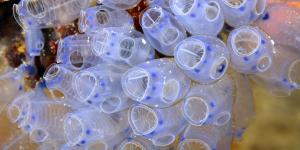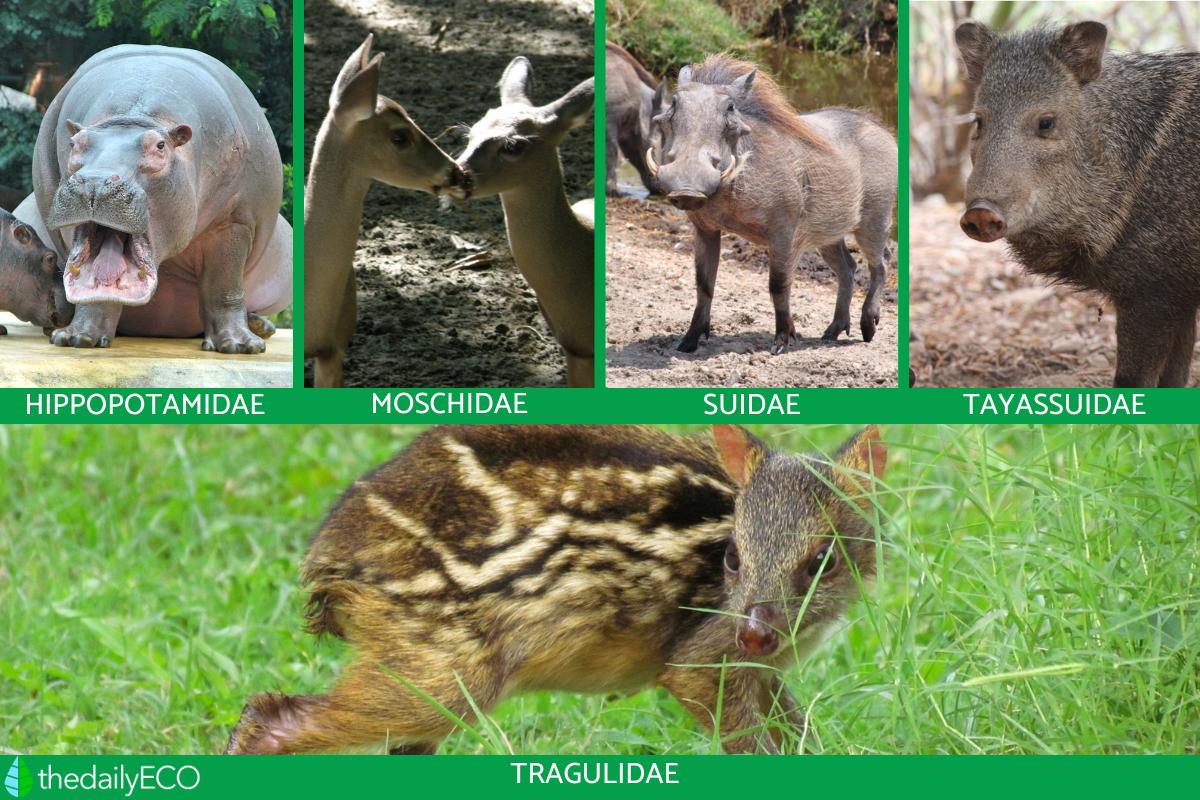What Are Even-Toed Ungulates?

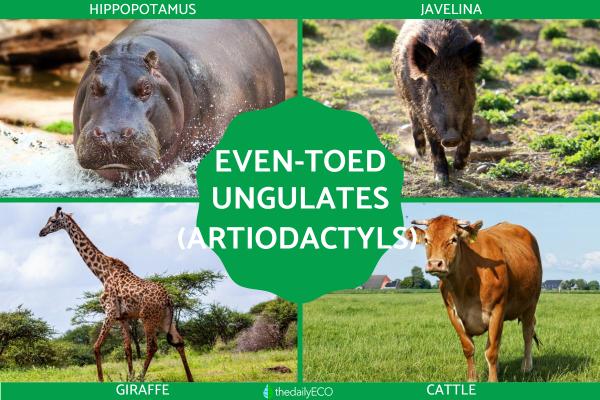
Although they may appear to be very different in form and behavior, there are great similarities between cows, giraffes and hippopotamuses. One of the most defining is the fact they are all artiodactyls, otherwise known as even-toed ungulates. While we have used these animals as examples, there are more than 220 species of artiodactyl mammals currently living around the world. Many of them remain only wild, but there are also examples of domesticated even-toed ungulates.
thedailyECO invites you to learn more about these beautiful animals by asking what are even-toed ungulates? In answering this question, we learn about the characteristics of artiodactyls and see examples of them in nature.
What are even-toed ungulates?
Even-toed ungulates are animals that belong to the order Artiodactyla. Otherwise known as artiodactyls, they are characterized by having an even number of fingers on their limbs. They are distributed throughout the world except in Antarctica and Australia. Although there are no native species of even-toed ungulate in Australia, they may be found in zoos and other animal reserves.
Fossils of artiodactyls have confirmed their existence 54 million years ago, during the Eocene period. Currently, the order includes 10 families, 86 genera and more than 220 species. Many of these animals have been domesticated and used for productive purposes by humans. Examples of domesticated even-toed ungulates include cows, pigs, sheep and llamas.
The study of the evolution of artiodactyls has not provided a specific origin of these types of mammals. According to current research, they appeared around the same time in Europe, Asia and North America. Although they are present in South America, this is to a lesser extent than other parts of the world. Learn about what animals which are present in this continent with our article on the flora and fauna of the Andean region.
Characteristics of artiodactyls
One of the particularities of artiodactyls is that they are hoofed animals, as are all types of ungulates. While it might seem likely even-toed ungulates have an even number of toes, this is not actually the case. Being referred to as ‘even-toed’ is due to the way they place their weight on their toes when they walk. While it may be the what gives even-toed ungulates their name, it is not their only defining characteristic. These include the following:
- They present a paraxonic condition, meaning the 3rd and 4th digits are well developed and their weight is placed on these digits. They can have up to 5 toes, but the others may be vestigial or maybe not there at all.
- In general, the toes are covered by keratin that forms a hoof.
- Most are herbivorous and terrestrial, although there are also omnivorous and semi-aquatic species (with one exception which we explain below).
- Although all mammals have glands, even-toed ungulates are known for having more glands than most which are important for their social and sexual lives.
- The presence of frontal appendages such as ossicones, horns or antlers is common.
- Most even-toed ungulates have gregarious habits, meaning they live in social cooperative groups.
- The stomach can be simple or with three or four chambers, be ruminant or non-ruminant.
- The upper incisors are usually absent or reduced.
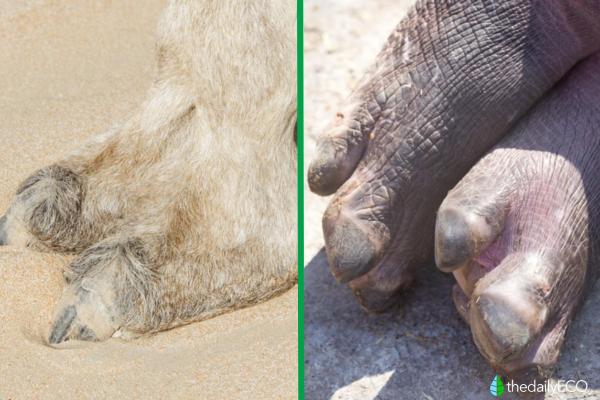
Classification of artiodactyl animals
Currently the order Artiodactyla includes 10 MAIN families which are constituted by various different species. Below, we look at the different families of even-toed ungulates and see some examples of each:
- Antilocapridae: includes a single species known as the pronghorn and is endemic to North America. It is an animal similar to the antelope, being a ruminant animal with horns in both sexes.
- Cervidae: includes the ruminant herbivores known as deer. They have four toes on each leg and bisected hooves. The males have antlers.
- Giraffidae: made up of only two species of giraffes that inhabit Africa. Both have horns covered by skin that are called ossicones. These are the two little horns which can be seen on a giraffe's head.
- Bovidae: it is the most numerous group and includes buffaloes, antelopes, gazelles, mountain goats, sheep, goats and cattle. They are distributed throughout the world and most have been domesticated. They are herbivorous animals and generally both sexes have permanent horns covered in keratin.
- Camelidae: made up of the herbivorous guanacos, camels, dromedaries, llamas, alpacas and vicuñas. Their hooves have two toes with strong nails and footpads.
- Hippopotamidae: here we find the hippos of Africa. They have four toes on each foot and their hooves have soft pads. Their stomach has three chambers, and their incisors and canines are continually growing. During the night they forage in the pastures and during the day they are submerged in water.
- Moschidae: made up of seven species of musk deer. Unlike the Cervidae, they do not have antlers. They are herbivores and inhabit forested areas and alpine scrub in Asia, especially in the Himalayas.
- Suidae: includes pigs, wild boars, babirusas and the warthog. They are omnivorous and ruminant animals found in forests or steppes. They have poor vision, but an excellent sense of smell.
- Tayassuidae: the family of peccaries, also known as javelinas. They are animals similar to pigs, with an elongated snout and a cartilaginous disc that ends with the nostrils. Their front feet have four fingers and the rear three. The stomach has three chambers and they are not ruminants. They are nocturnal and omnivorous, inhabiting forests and steppes, generally living in groups.
- Tragulidae: contains ten species of chevrotains, commonly known as mouse deer. They have neither antlers nor horns, but they have four fingers on their limbs and a stomach with four chambers. They are ruminants. Almost all species are herbivorous although some species feed on insects and small mammals.
Although these are the main families of even-toed ungulates, there is another infraorder which needs mentioned. They are particularly exceptional due to the fact they do not have toes at all. This is because whales, dolphins and porpoises from the infraorder Cetacea are also considered Artiodactyla. We know this thanks to investigations using molecular biology during the 1990s[1].
Due to the discovery of such a close link between cetaceans and other even-toed ungulates, some taxonomists use a different terminology by using the order Cetartiodactyla, rather than Artiodactyla on its own. Others will simply include cetaceans in the order Artiodactyla.
Learn some fascinating facts about one such aquatic even-toed ungulate with our article on wh

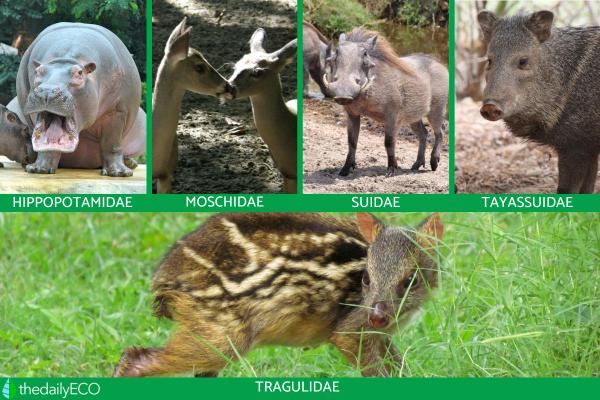
Examples of artiodactyls
Within the families of artiodactyls that we have named, there are more than 220 individual species. While we have provided some examples in the families above, we want to highlight some more examples indicative of even-toed ungulates:
Gemsbok (Oryx gazella)
This is a large antelope that belongs to the Bovidae family. A distinctive feature is their black mask around a white snout. They inhabit arid plains and deserts, although they can also found on rocky slopes and dense scrubland. It is herbivorous and they make up groups of 30 to 50 individuals. Both sexes have horns, although that of the female is shorter and thinner.
Guanaco (lama guanicoe)
The guanaco is the tallest mammal in South America and belongs to the Camelidae family. It has long legs and a long neck with a woolly coat. They are a herbivorous species found in open habitats such as steppes, grasslands and mountains. They are diurnal and gregarious, living in groups of 4 to 20 individuals, where there is usually a single male accompanied by females and young. The young males usually form separate groups among themselves.
Wild boar (sus scrofa)
Within the Suidae family we find the wild boar, an animal with a robust body. Their well-developed tusks grow continuously and curve inwards. They live in areas with good vegetation cover. Their groups consist of approximately 20 individuals made up of females, young and juveniles. Male wild board are solitary animals. They are omnivorous, nocturnal and crepuscular, using their extremely acute sense of smell to locate food.
Learn about the habitats of some even-toed ungulates with our article on animals that live in temperate forests.
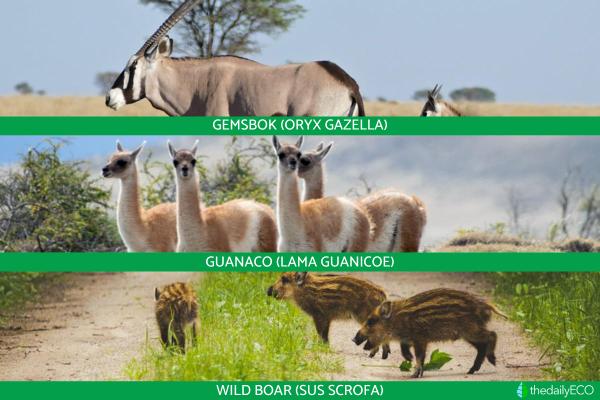
If you want to read similar articles to What Are Even-Toed Ungulates?, we recommend you visit our Biology category.
1. Shimamura, M., Yasue, H., Ohshima, K., Abe, H., Kato, H., Kishiro, T., Goto, M., Munechika, I., & Okada, N. (1997). Molecular evidence from retroposons that whales form a clade within even-toed ungulates. Nature, 388(6643), 666–670.
https://doi.org/10.1038/41759
- Biodiversity Information System. Available at: https://sib.gob.ar/portada
- Alvarez Romero, J., Medellin Legorreta, R. A. (2005). Oryx gazella. Retrieved from: http://www.conabio.gob.mx/conocimiento/exoticas/fichaexoticas/Oryxgazella00.pdf
- Garrido, G. (2008). General information about the upper Villafranquiense artiodactyls in relation to the fossil record of P-1 phonenels. Retrieved from: https://www.igme.es/epvrf/docs/FONELAS_16.pdf

